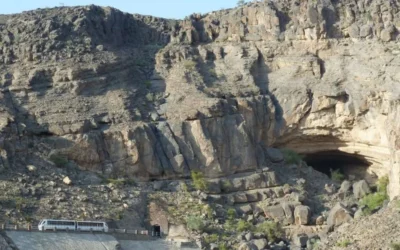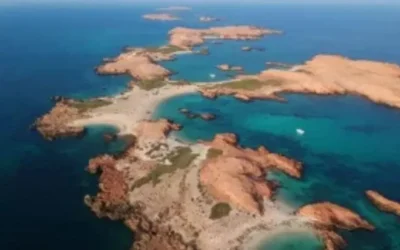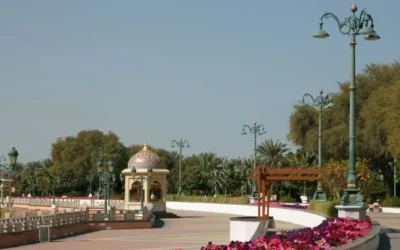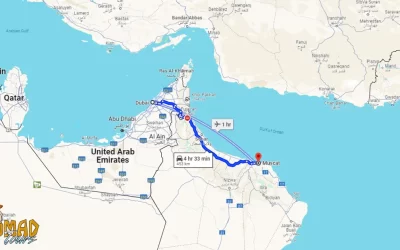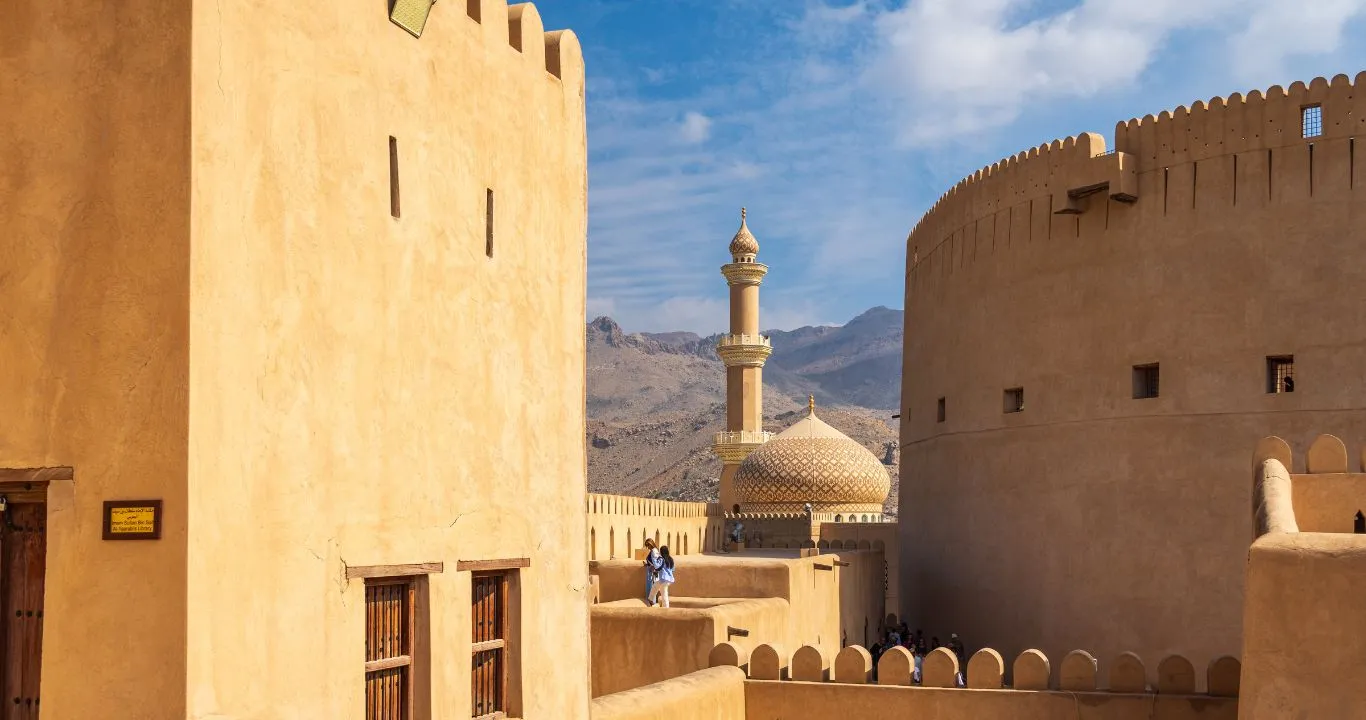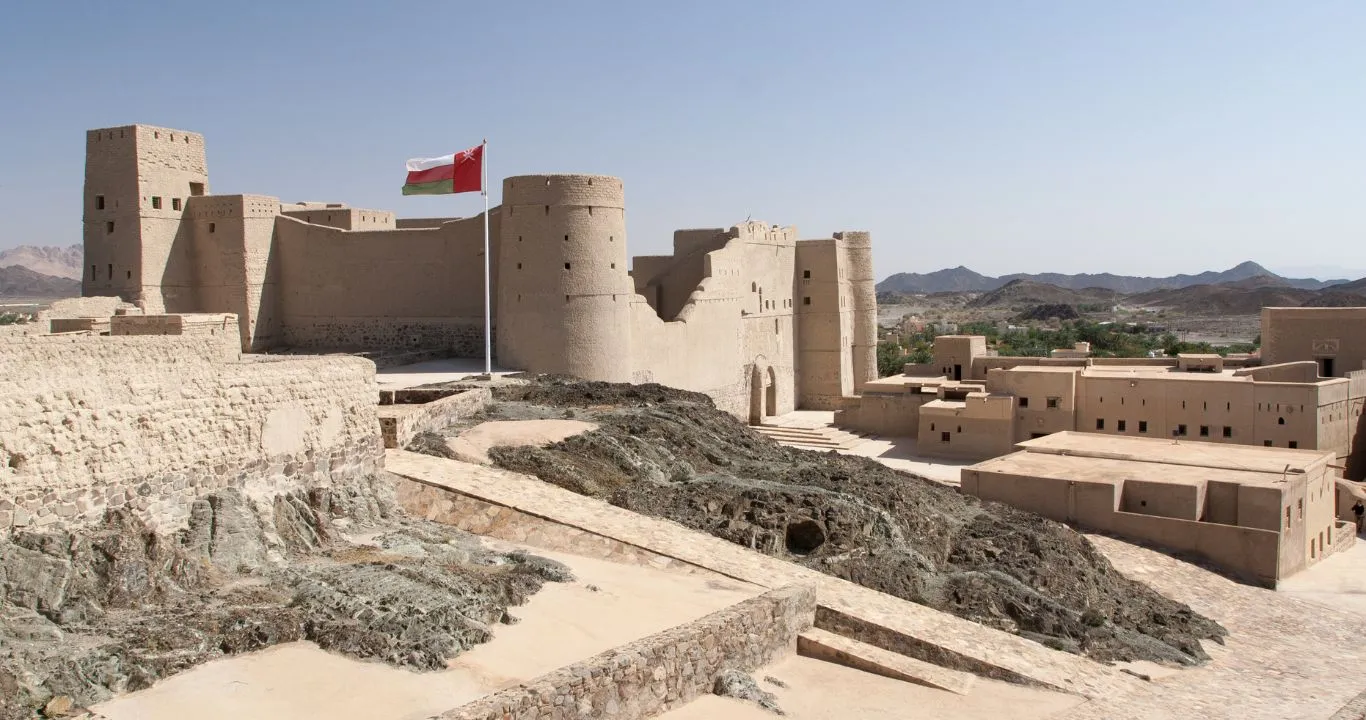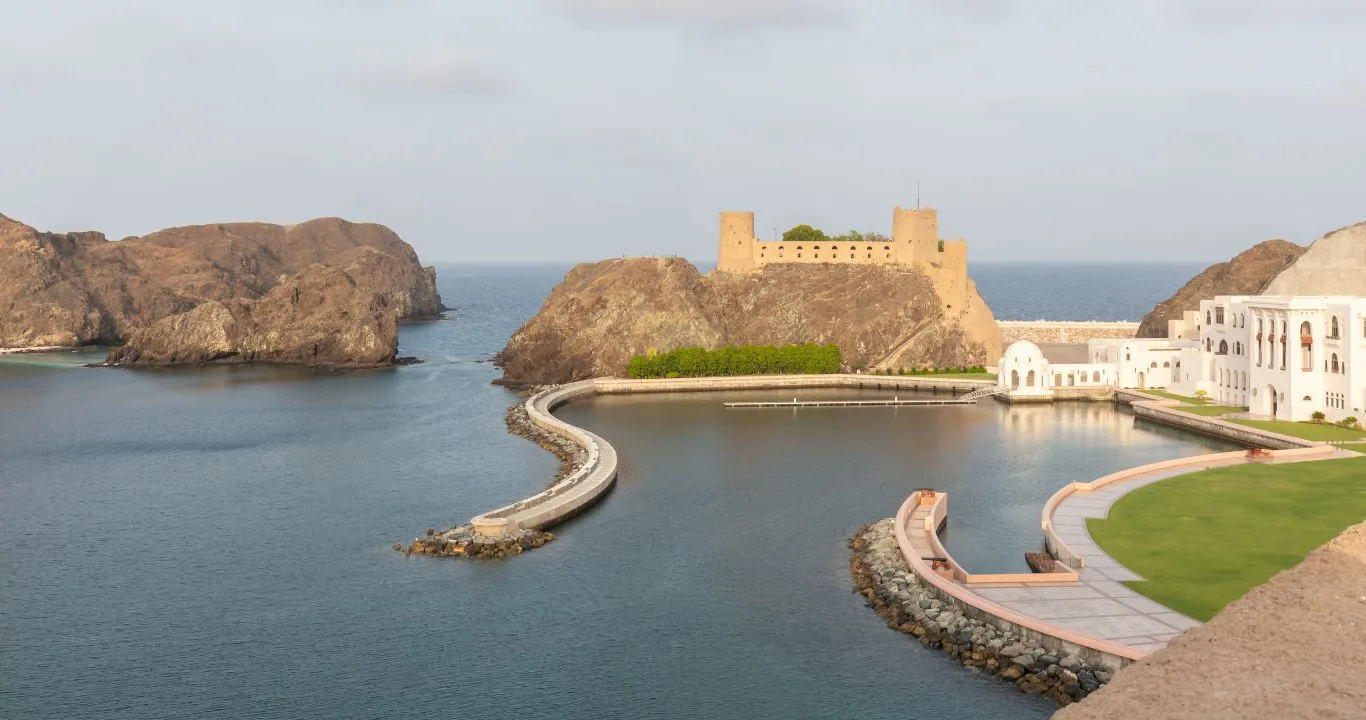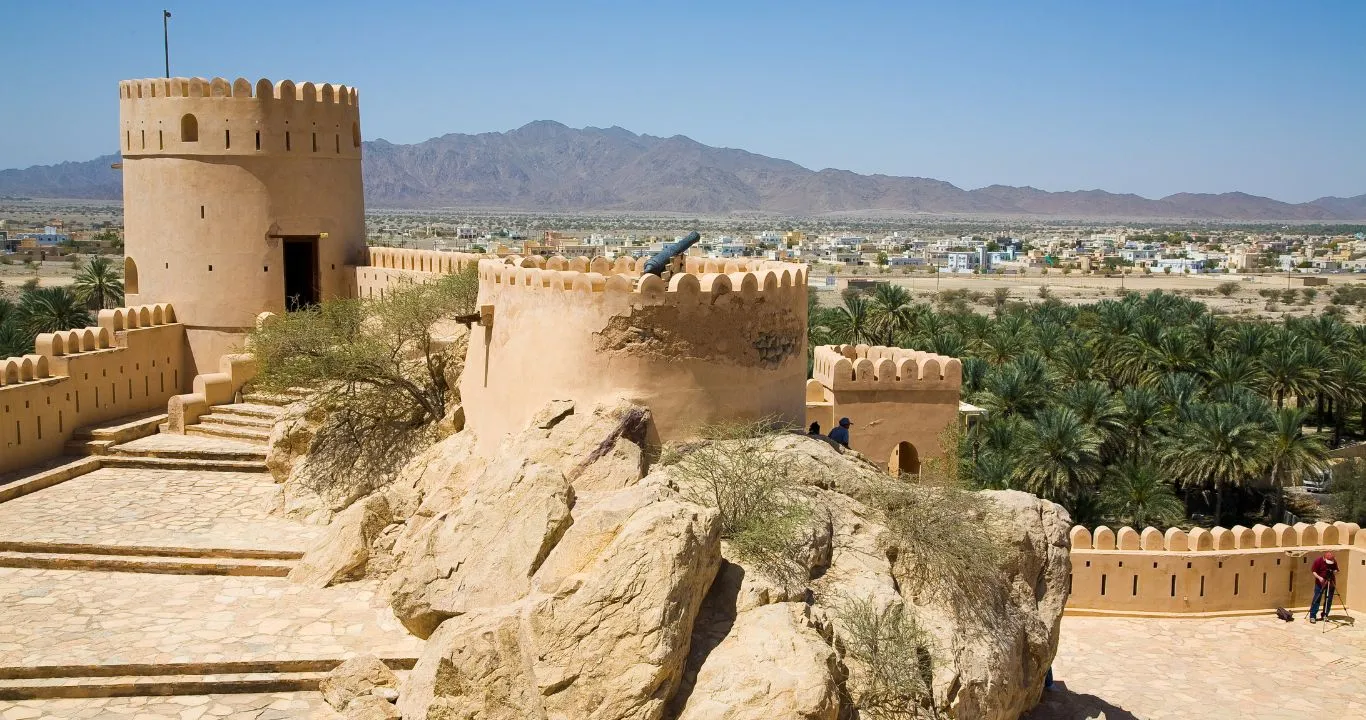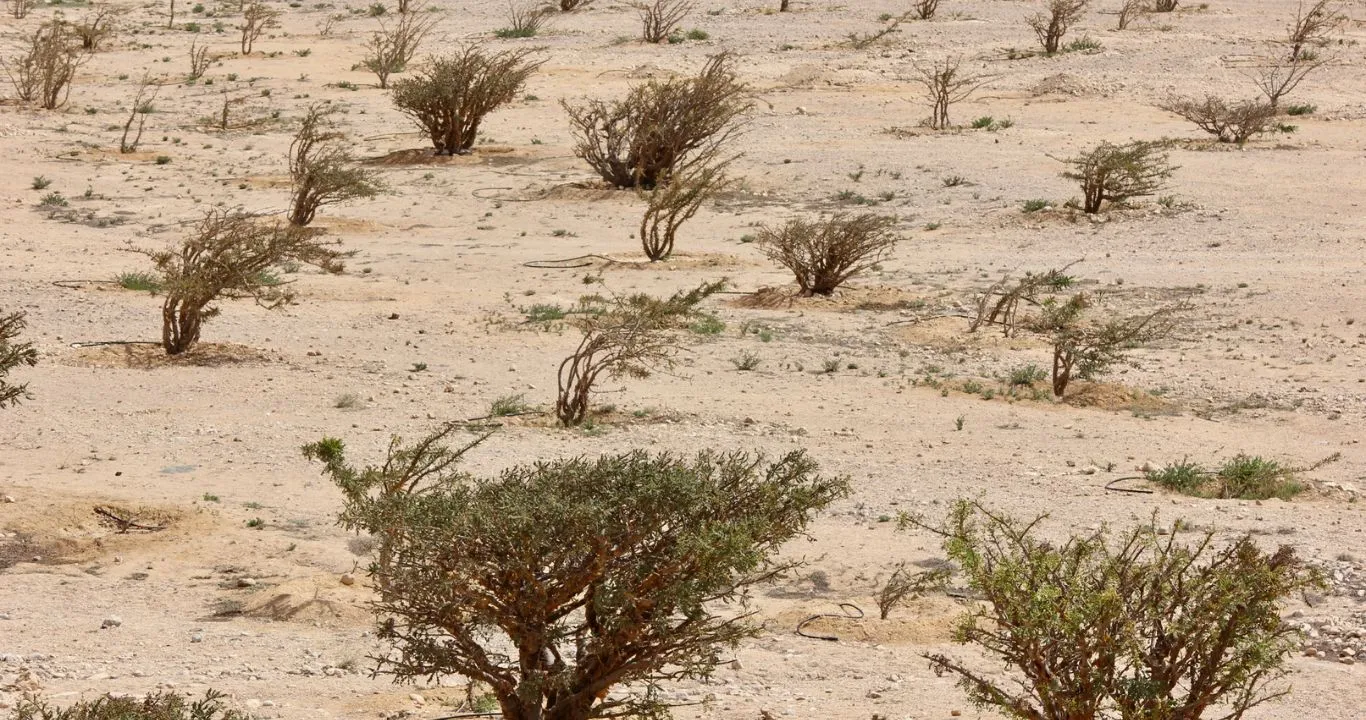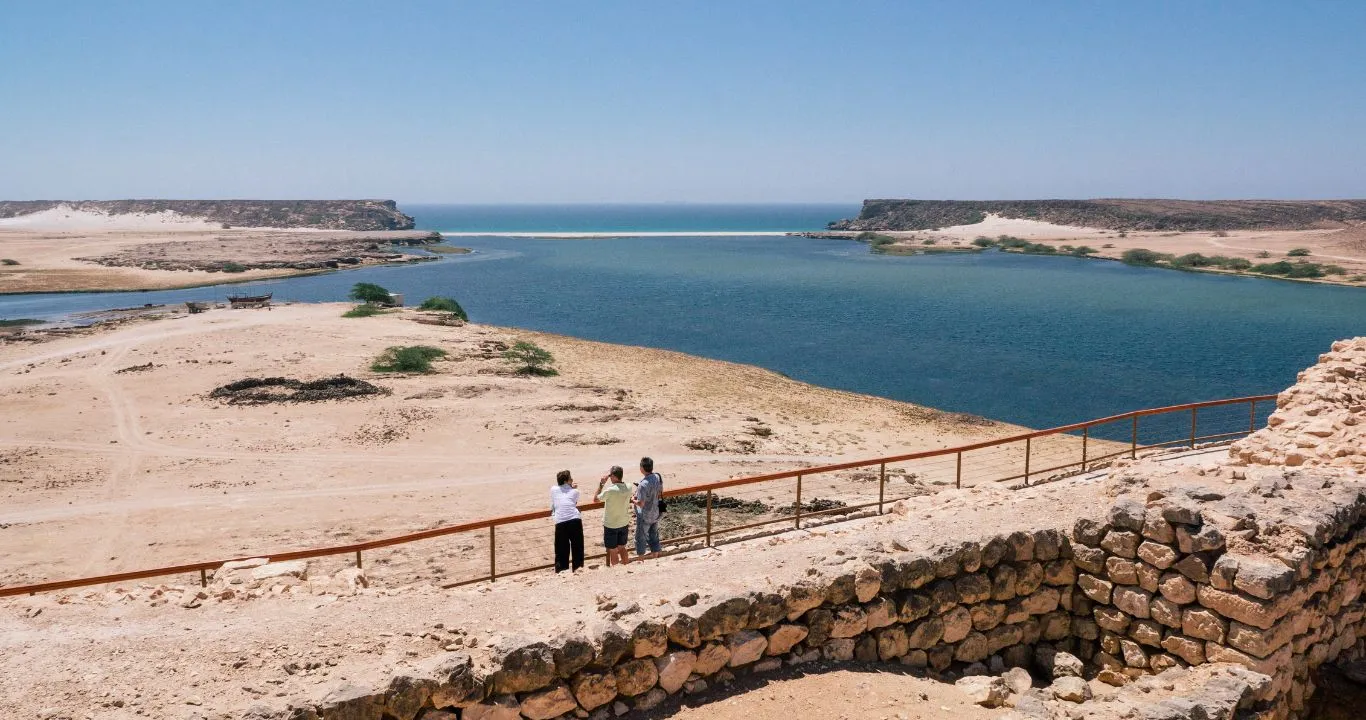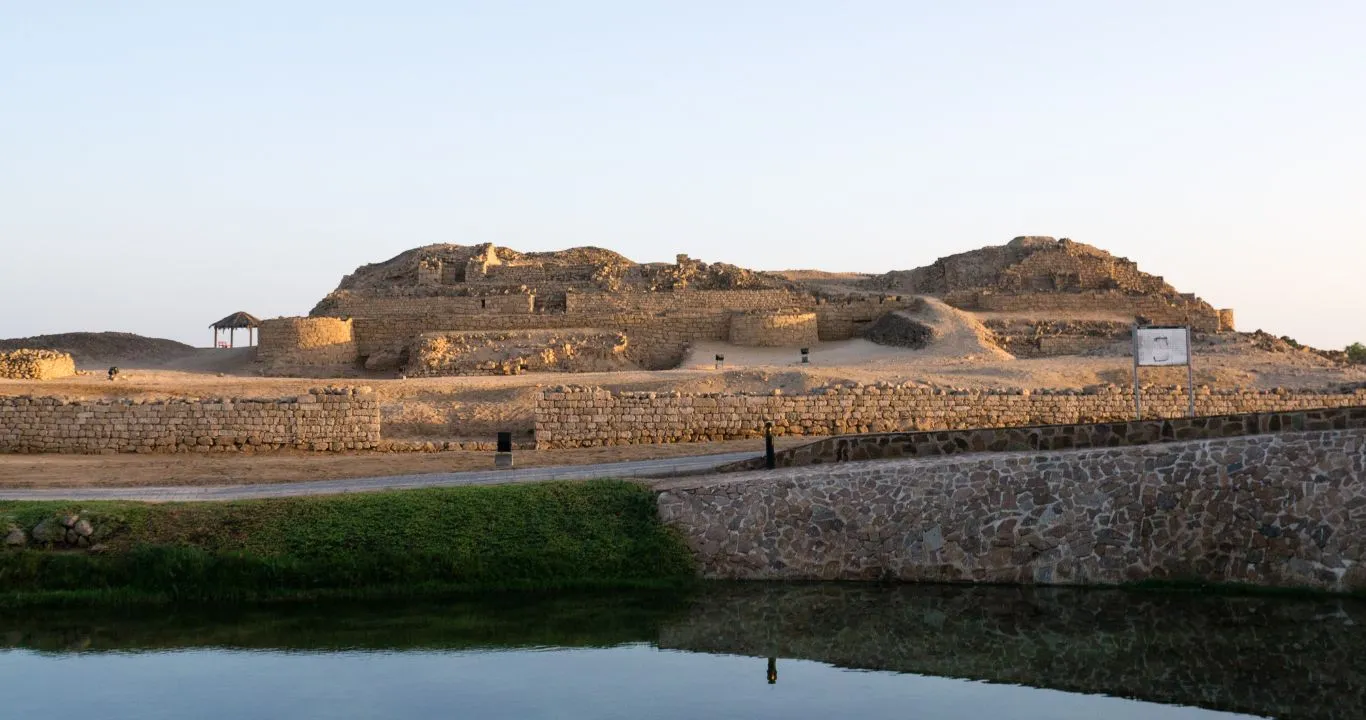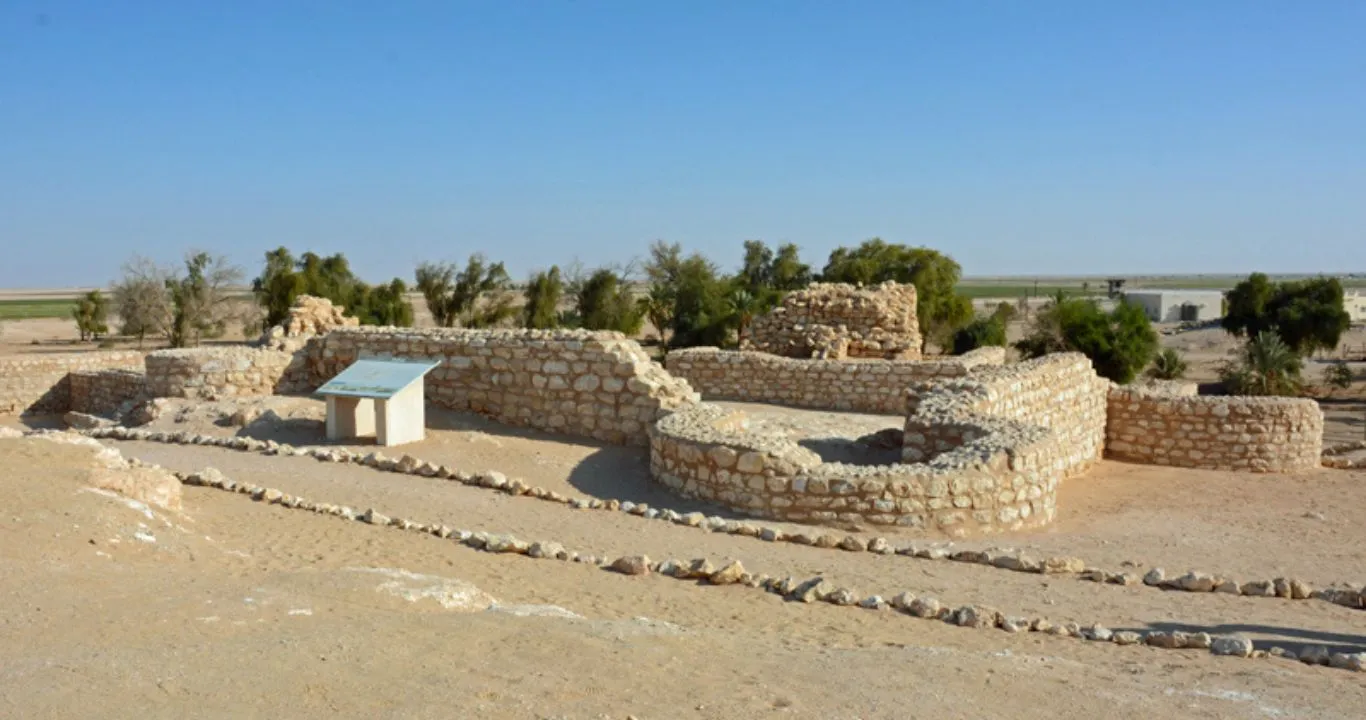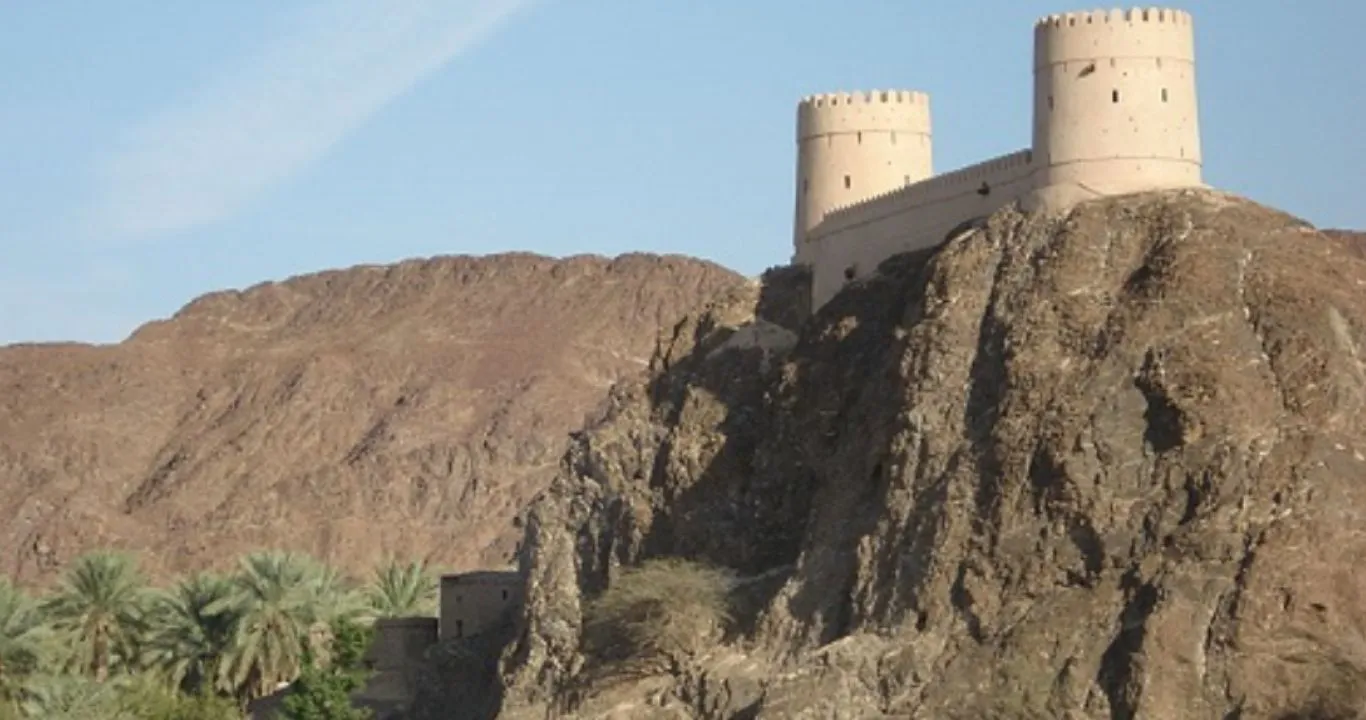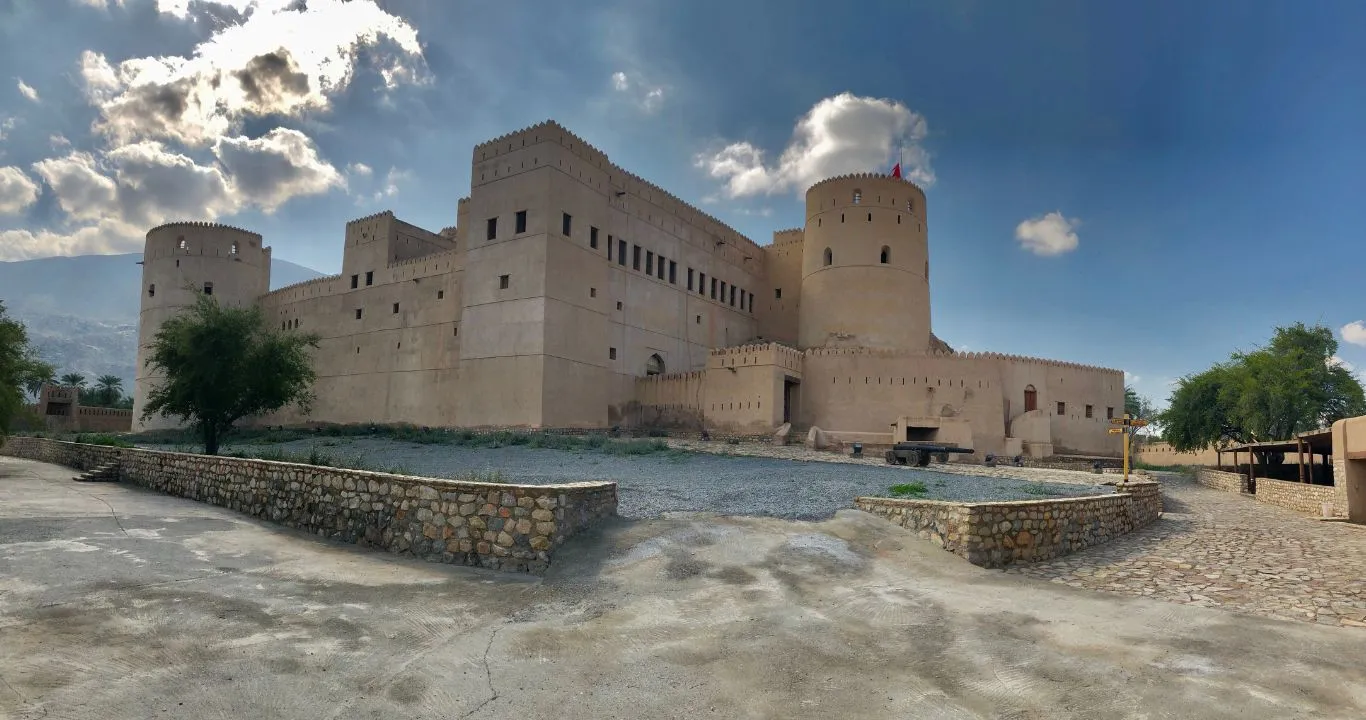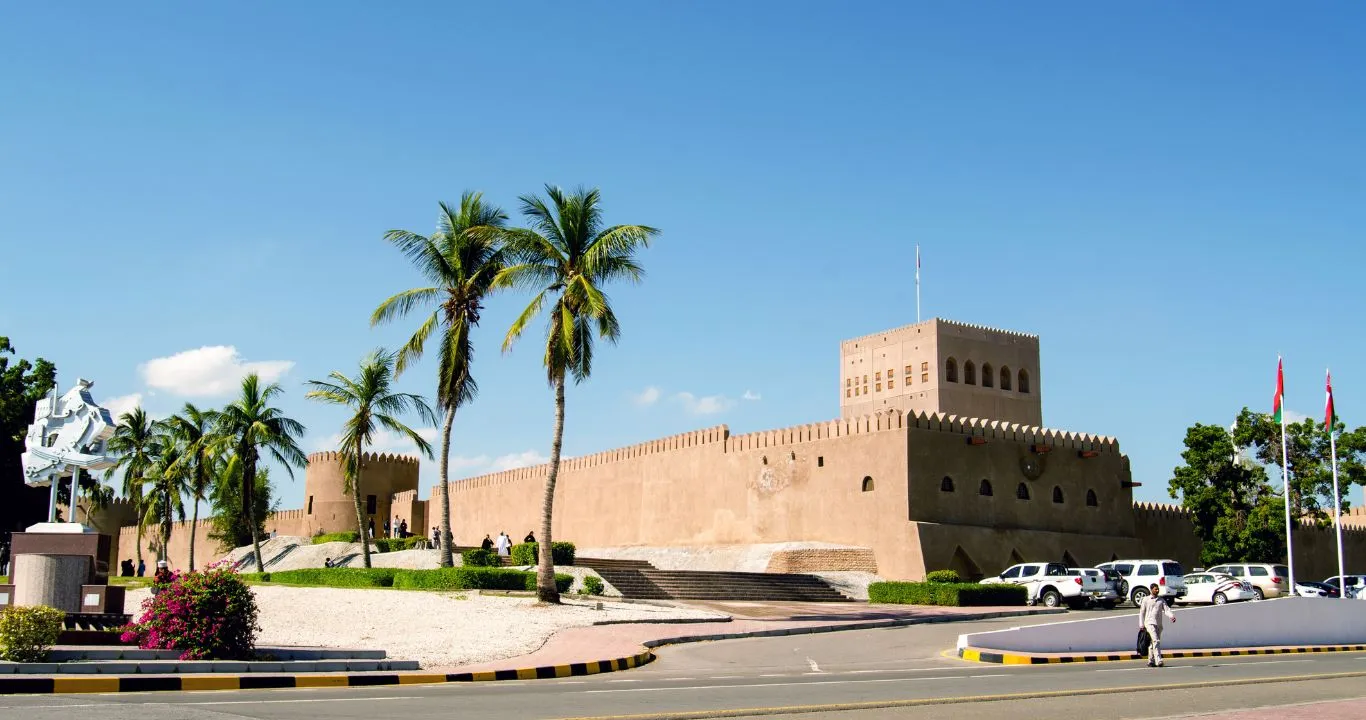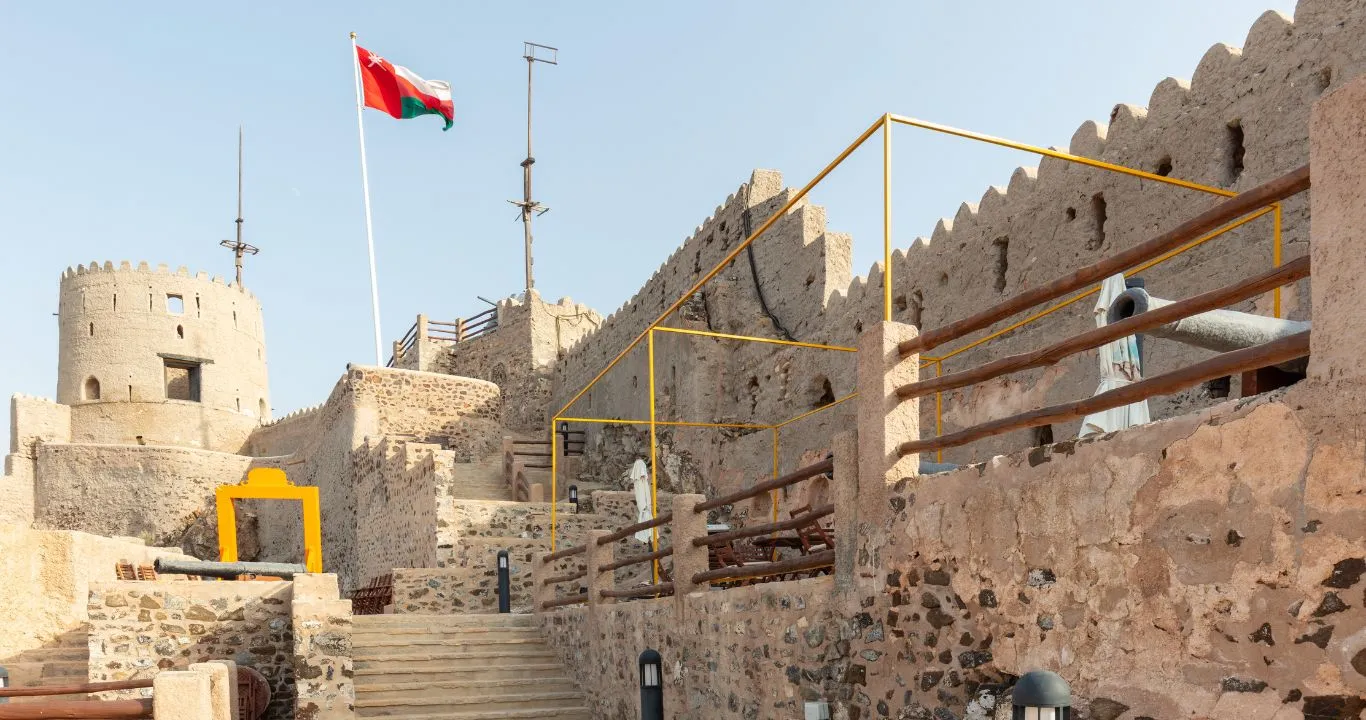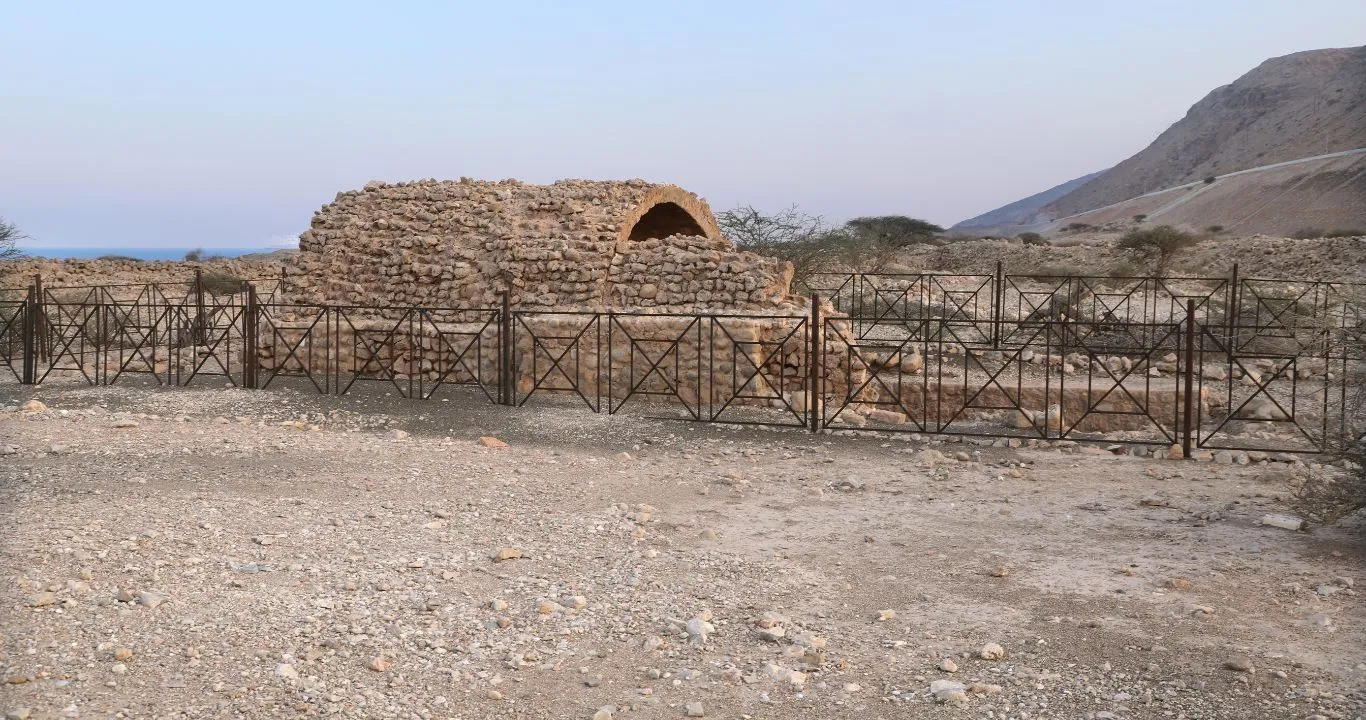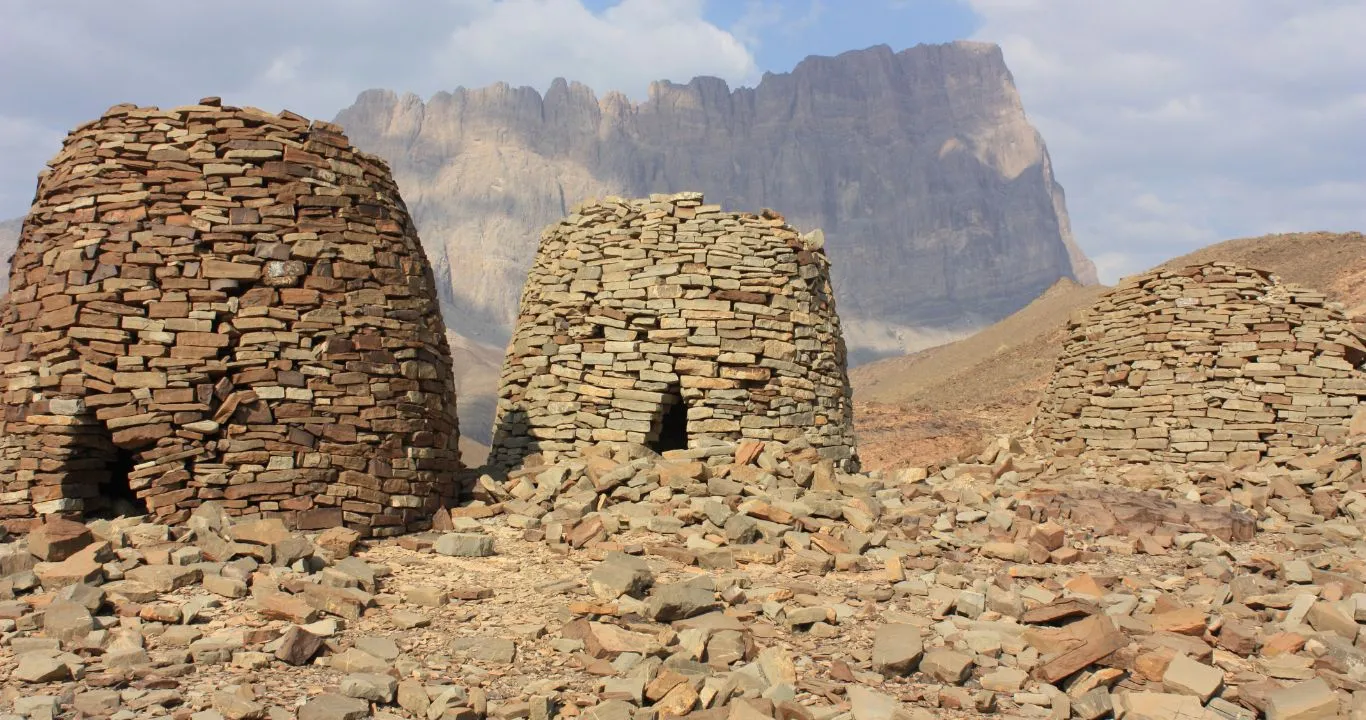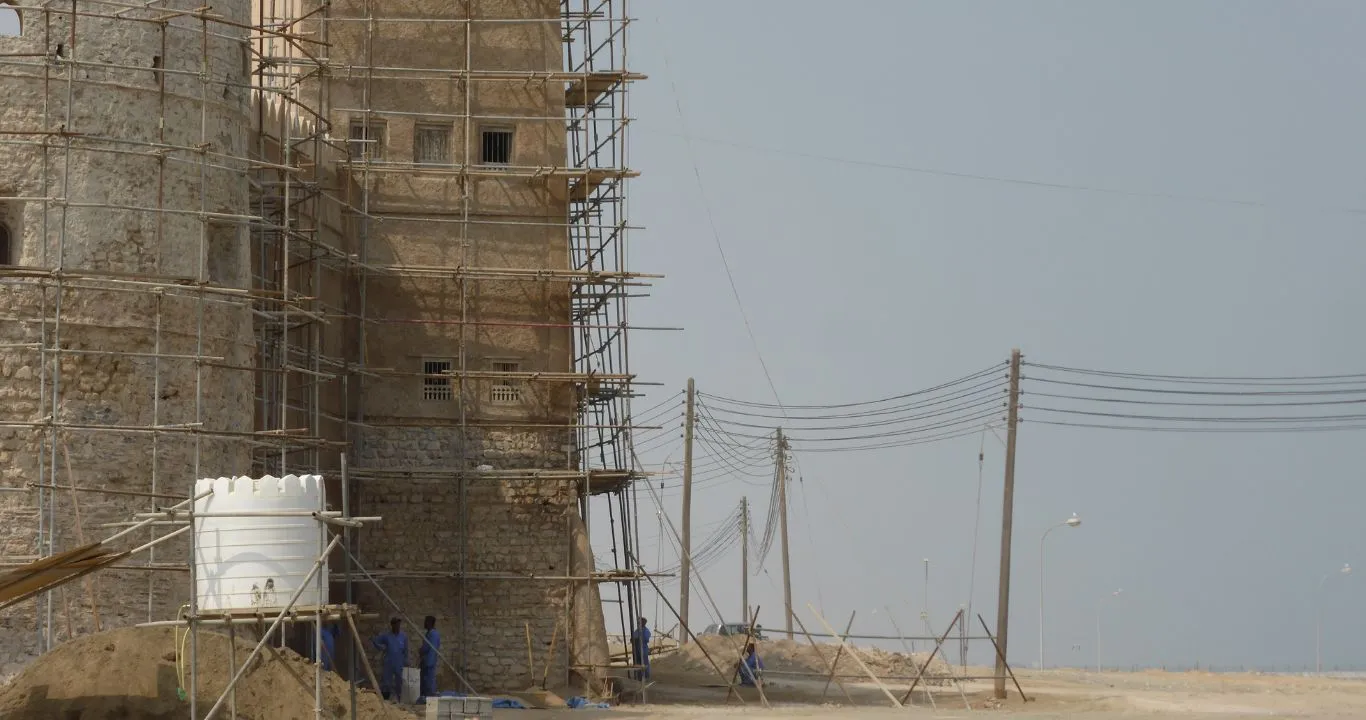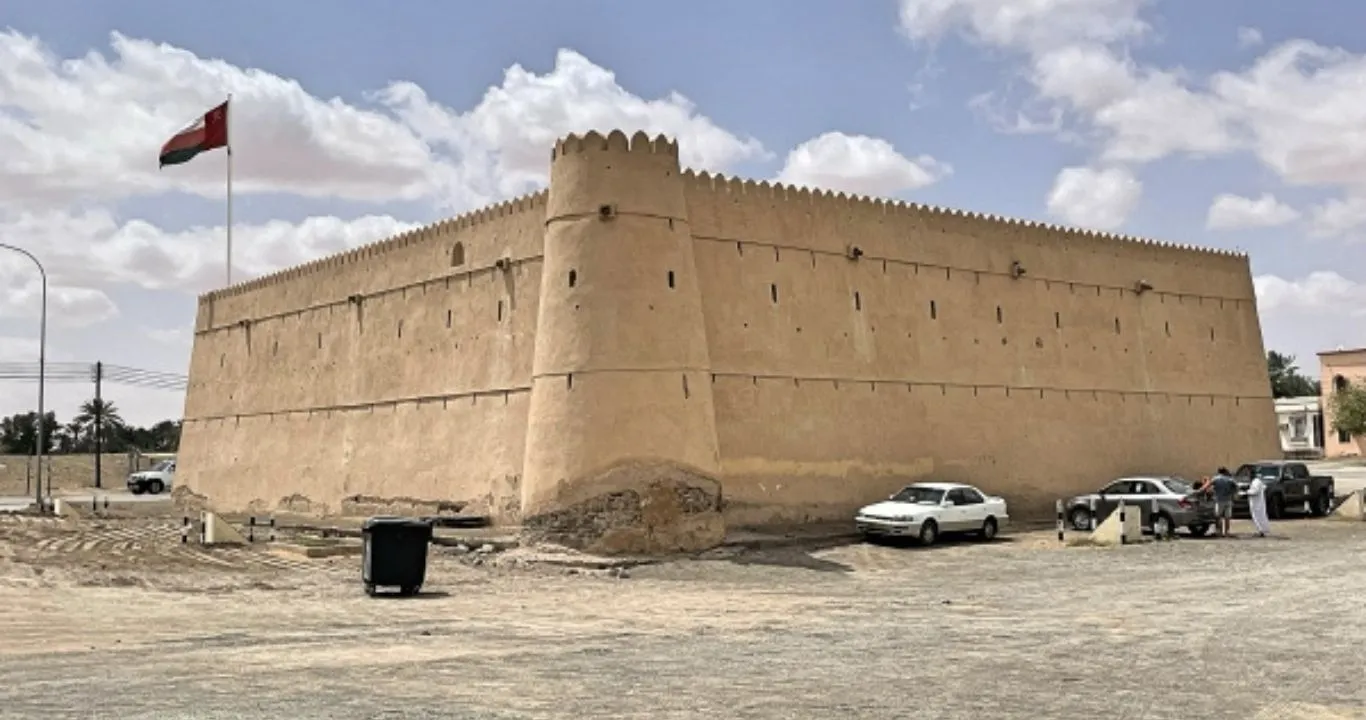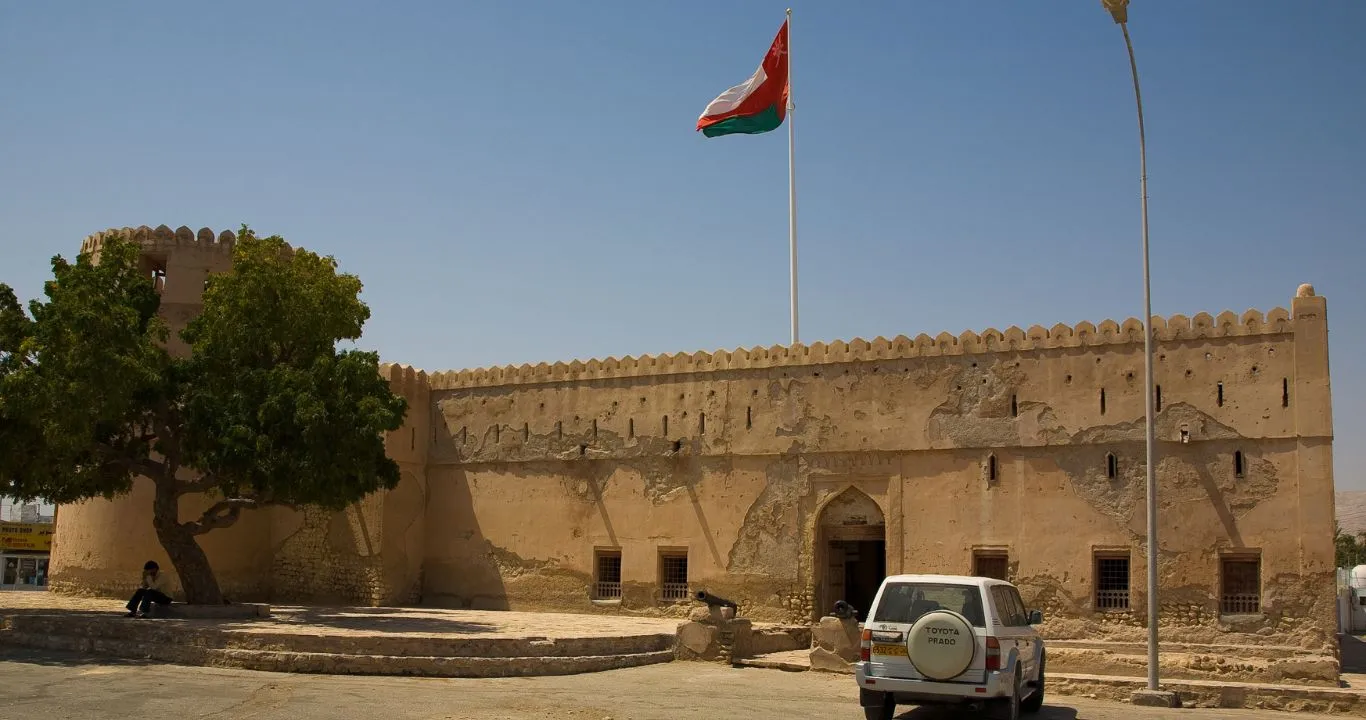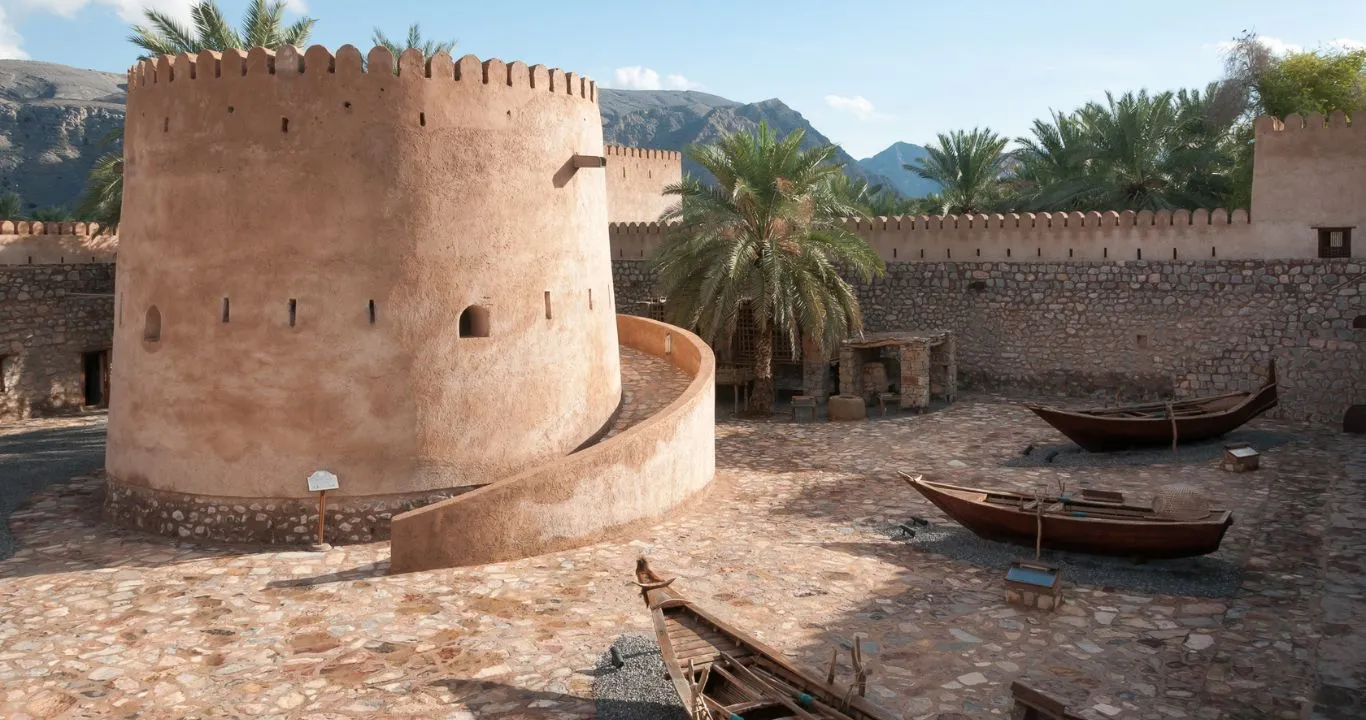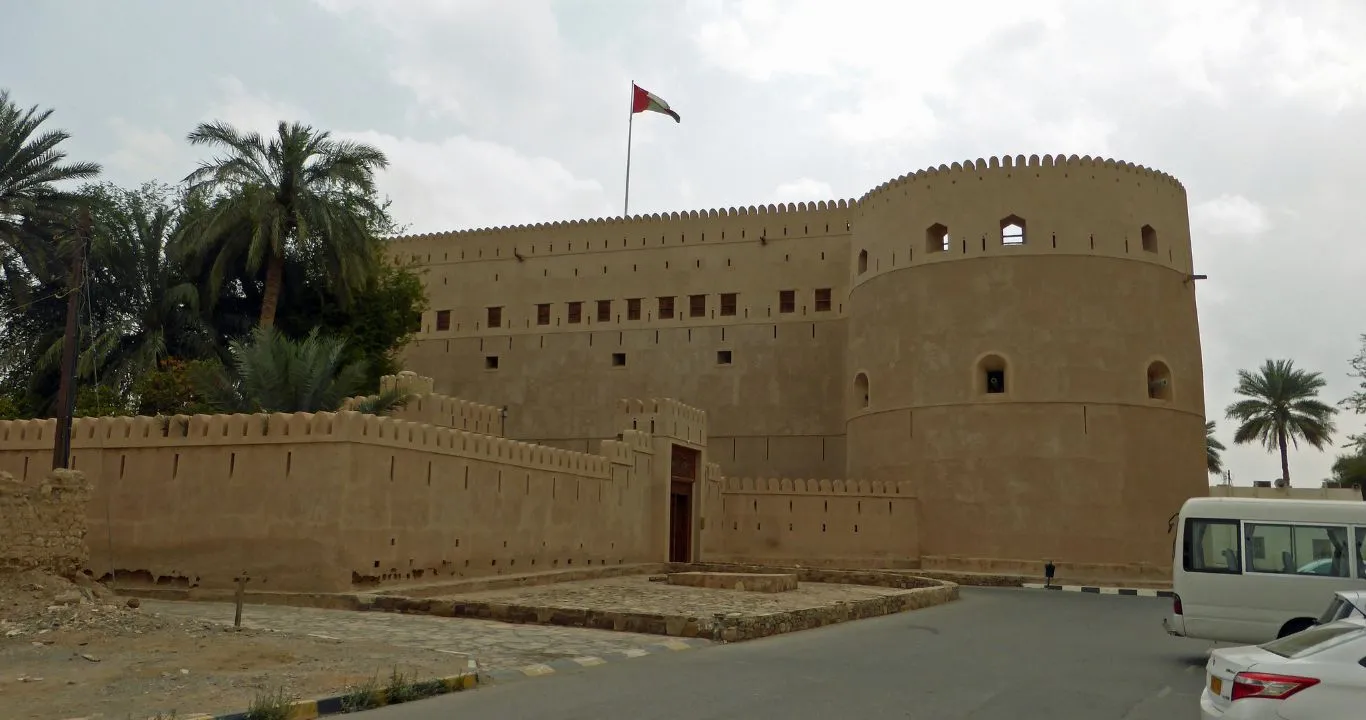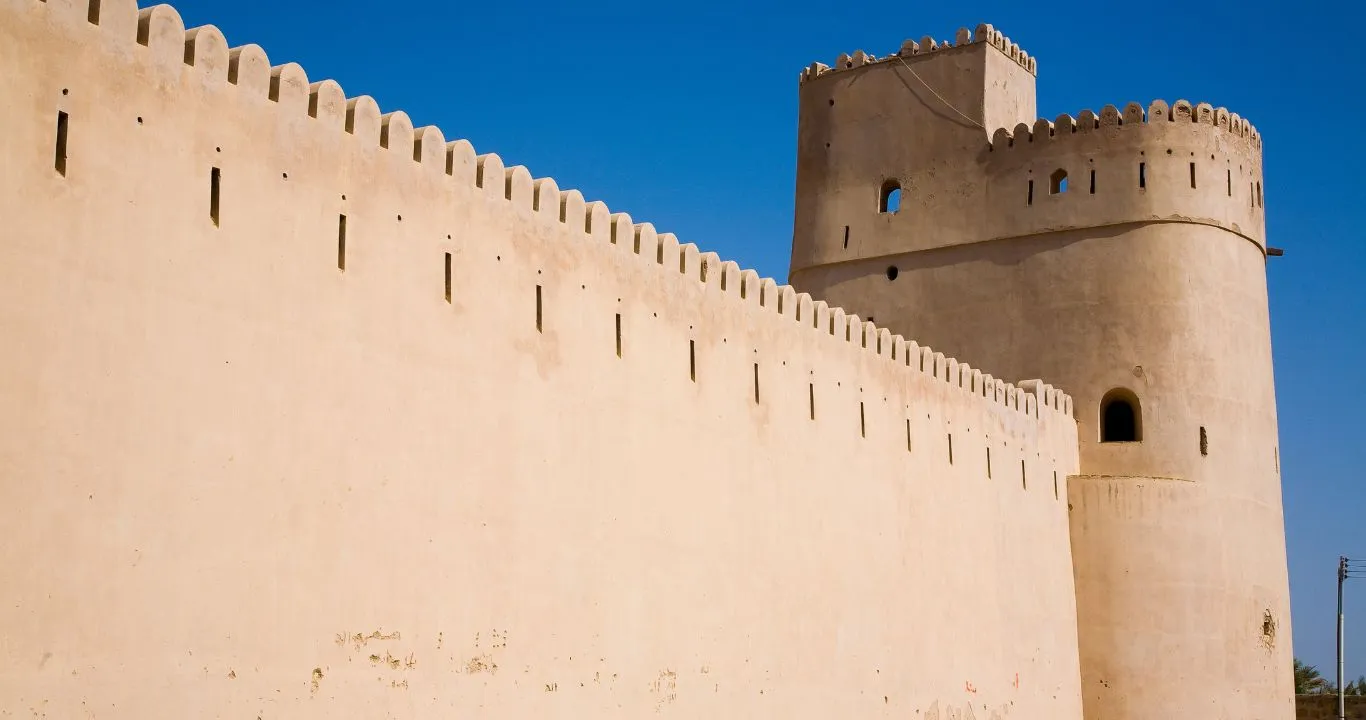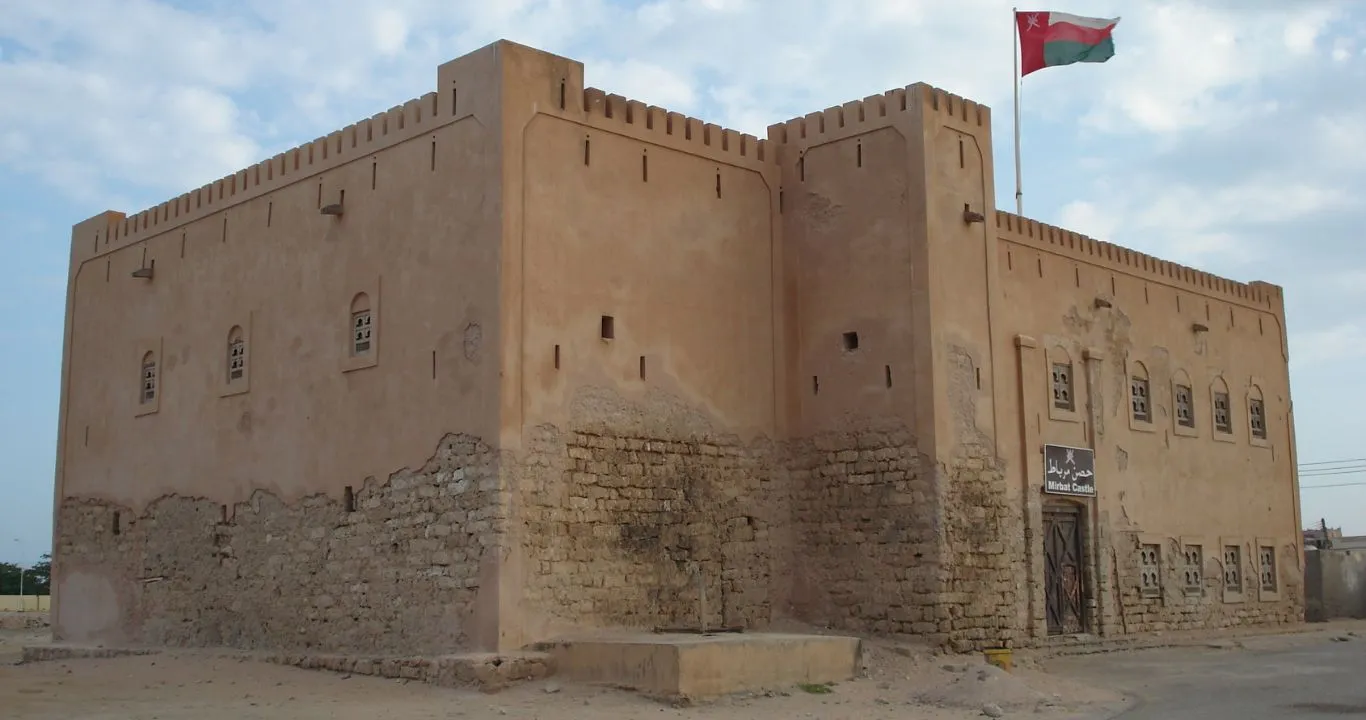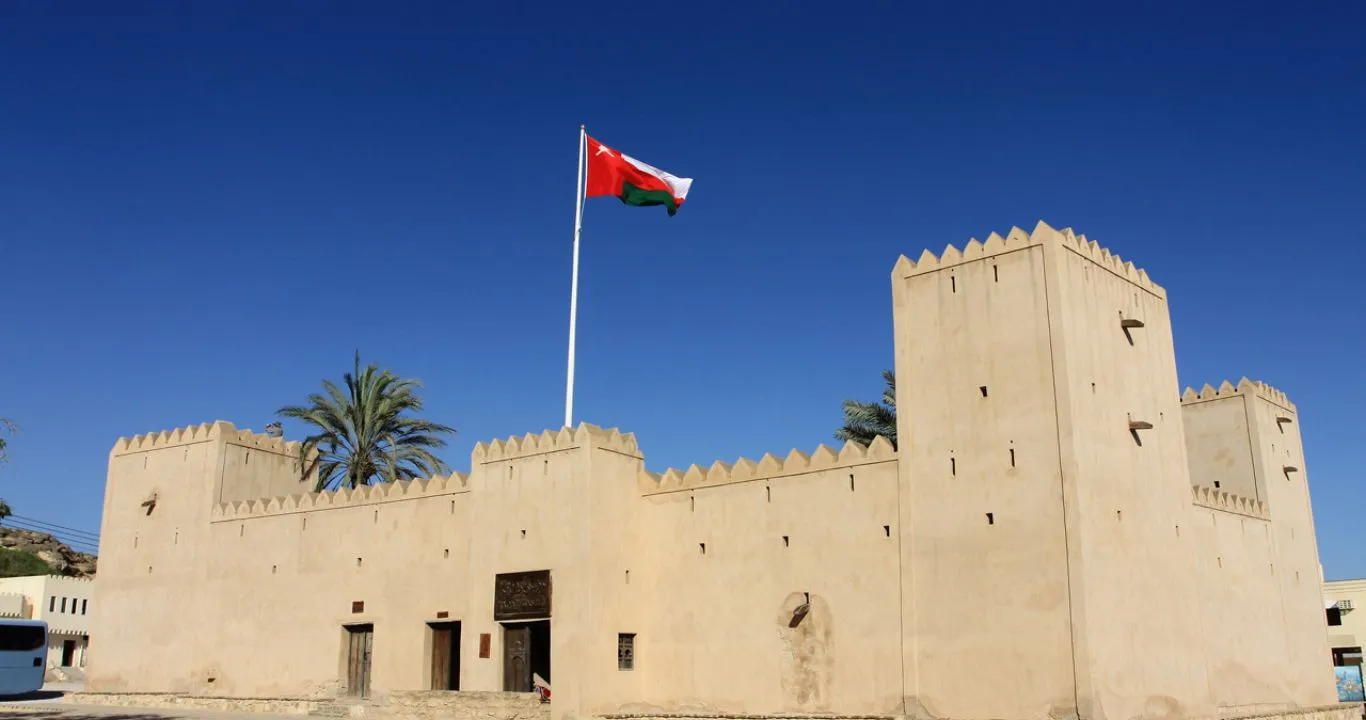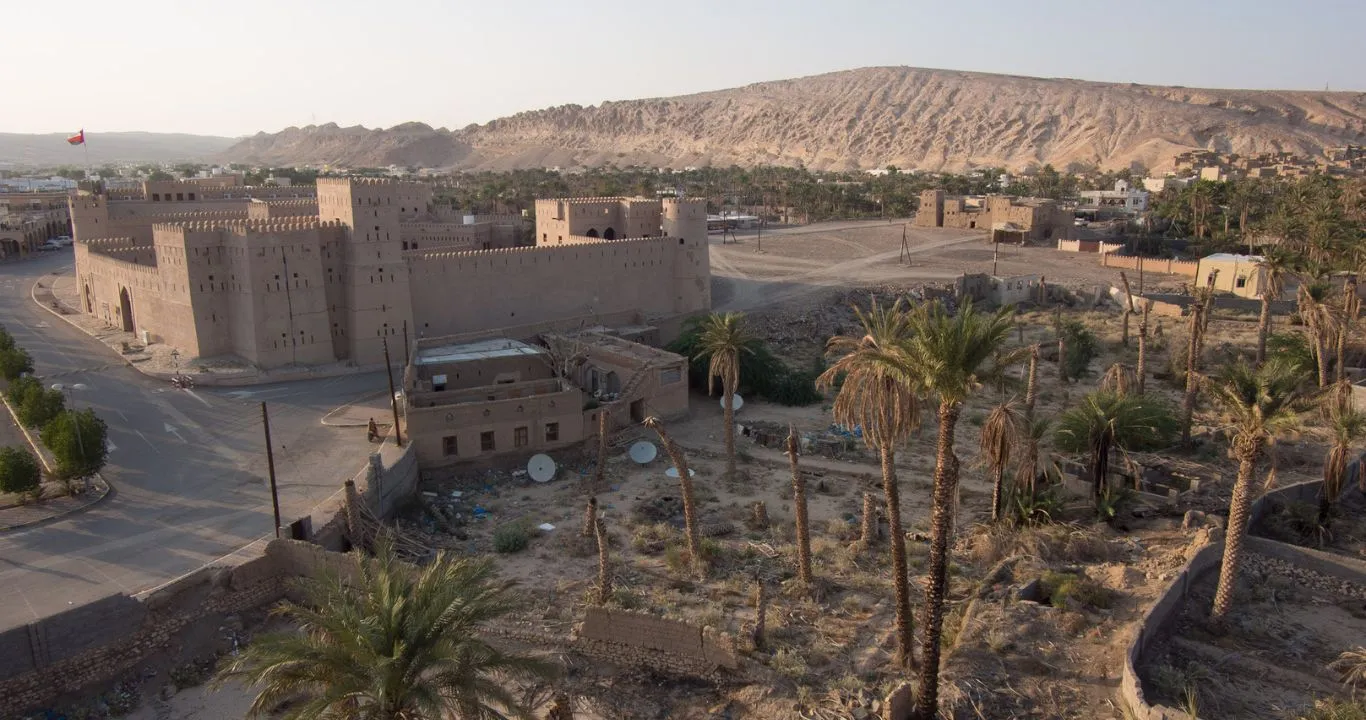The Sultanate of Oman is beyond majestic mountains, pristine beaches, amazing wadis and breathtaking deserts. The country has abundant forts and castles in every nook and corner. The abundance, however, does not mean that the individuality of these forts and castles is compromised.
Many of these forts and castles of Oman are UNESCO World Heritage sites. Some date from the era of Portuguese rule, while others are more ethnically diverse.
This article will discuss the list of forts and castles and reveal Oman’s ancient history, roots, and background.
- Nizwa Fort
- Bahla Fort
- Al Mirani Fort
- Al Jalali Fort
- Nakhal Fort
- Khor Rori
- Samail Fort
- Khasab Castle
- Al Hazm Castle
- Rustaq Fort
- Sohar Fort
- Wadi Dawkah
- Muttrah Fort
- Shisr
- Mirbat Castle
- Bilad Sur Castle
- Taqah Castle
- Ancient City of Qalhat
- Al-Ayn
- Barka Fort
- Al-Baleed Archaeological Site
- Ibri Castle
Nizwa Fort
Nizwa Fort is one of the most prominent and historic forts of Oman. It was built by Imam Sultan bin Saif bin Malik Al Yarubi in the seventeenth century; however, the underlying structure dates back to the eleventh century. Nizwa Fort was built in 12 years.
Nizwa Fort was the residence of imams and other critical government personnel during the Yarubi rule. The fort was built to defend the city from attacking forces and protect it from invaders.
dconvertini, CC BY-SA 4.0, via Wikimedia Commons
Bahla Fort
The Bahla Fort was built on a rocky mountain to overlook the surrounding areas for protection and defence. It is situated in the Wilayat of Bahla. This fort is distinguished among the forts and castles of Oman as it was the first archaeological site to be included in the UNESCO World Heritage site in 1987.
The Bahla fort is built with bricks and mud. The towers are designed strategically to protect the surrounding palm oasis.
Ekrem Canli, CC BY-SA 4.0, via Wikimedia Commons
The Bahla Fort Winter festival is one of the most prominent annual festivals in the country. This festival celebrates the art and culture of Oman. So, if you are an art and heritage lover, you must plan your visit in winter to attend this festival.
Al Mirani Fort
This more than 400-year-old 16th-century fort stands tall on the rocky hills overlooking the harbour of Muscat. This ancient fort has seen Portuguese invasion, Ottoman attacks, and Omani victory.
The fort’s original structure was built long before the Portuguese arrived. However, the Portuguese rebuilt it in 1587-1588, making it an unassailable military base. The Al Mirani Fort was laced with cannons and other critical military essentials.
Diego Delso, CC BY-SA 4.0, via Wikimedia Commons
Today, Al Mirani Fort stands tall above Muscat and is celebrated as a symbol of Oman’s resilience and bravery. Tourists can visit the fort after paying the entry fee of 10 OMR, where they can experience the work of local artists, which is displayed.
You might be interested in:
Muscat City Tour
Al Jalali Fort
Al Jalali Fort, also known as As Sharqiya Fort, was built by the Portuguese in the 1580s. This fort has a long history of sieges and attacks. Omani forces recaptured Al Jalali Fort in 1650, but the Persians besieged the fort during the civil war.
Al Jalali Fort was extensively rebuilt later. It was long used as a prison for royal family members and then served as Oman’s central prison until the 1970s. In 1983, it was converted into a museum.
The Al Jalali Fort museum is only open to dignitaries and high-ranking foreign officials. Tourists can admire the beauty of this fort from the outside.
Diego Delso, CC BY-SA 4.0, via Wikimedia Commons
The Al Jalali Fort museum is only open to dignitaries and high-ranking foreign officials. Tourists can admire the beauty of this fort from the outside.
Nakhal Fort
Nakhal Fort is located in the Al Batinah Governorate of Oman. It is named after the palm oasis that surrounds it. The fort’s history dates back almost 1500 years; however, the exact date and origin of this fort are still unknown. Historians link Nakhal Fort to pre-Islamic times.
Andries Oudshoorn, CC BY-SA 2.0, via Wikimedia Commons
Nakhal Fort is a famous tourist spot. Travellers can visit the fort, but check the latest opening hours on the Ministry of Tourism’s official website.
The entry fee for Nakhal Fort is 500 baizas.
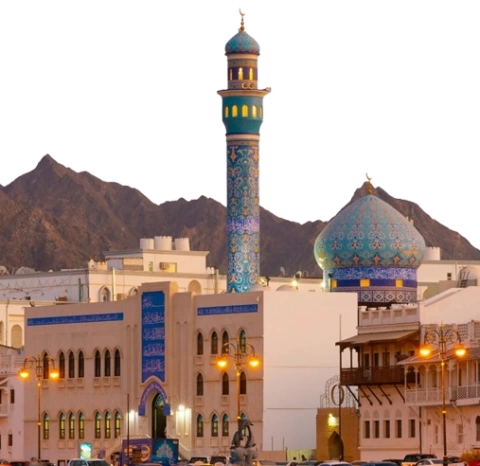
Muscat City Tour Packages
Our city tour Muscat Oman is a mix of culture, history and architecture, perfect for those who want to experience the real deal.
Land of Frankincense
The Land of Frankincense, a UNESCO World Heritage site, is another jewel in the crown of the Sultanate of Oman. Frankincense is a tree that produces an exclusive resin used in perfumes and incense. This resin has been a luxury trade item since ancient times. The land of frankincense is the term used for the collection of these four areas, which were associated with the trade of Frankincense in the olden times.
- Wadi Dawkah
- Khor Rori
- Al Baleed
- Shisr
Wadi Dawkah
Wadi Dawkah is a wadi in the Dhofar region of Oman. It is famous for its frankincense vegetation. The ancient frankincense trees continue the Omani heritage and cultural legacy.
Armatus1995, CC BY-SA 4.0, via Wikimedia Commons
Frankincense, also called Gold of the Desert, has been Oman’s luxury trade item for centuries.
You might be interested in:
Desert Crossing
It is a UNESCO World Heritage site since 2000 and is well preserved and managed by the Omani Government. Visitors can visit Wadi Dawkah and see the collection and usage process of frankincense resin.
Khor Rori
Khor Rori is an ancient port ruin. Remains of a city and a fort are also present at Khor Rori. It is located 40 km to the east of Salalah. Khor Rori is present on a hilltop at the bank of a creek.
Khor Rori was a significant port in the incense trade in the Dhofar region. It was functional in the 1st century BC. The remains of the fort are associated with Khor Rori. The fort was built to protect the incense trade from invaders.
The ruins of Sumharam, discovered in 1996, are also present at Khor Rori. Today, we can still see a walled city with houses, public buildings, storage rooms for incense, temples, and other essential things from this earliest settlement in Oman.
Juozas Šalna, CC BY 2.0, via Wikimedia Commons
Tourists are allowed to visit these remains at a nominal entry fee. If you love history, then you must plan a visit to this lost ancient port and city of Oman.
You might be interested in:
Tours of Oman
Al-Baleed Archaeological Site
The Al Baleed Archaeological Site is your gateway to this region’s rich past. It is associated with the remains of the magnificent city of Zafar, which thrived between the 8th and 16th centuries BC. The famous travellers Marco Polo and Ibn Battuta also visited this city, praising its grandeur and importance.
The AL Baleed archaeological site presents what is left of a port and city vital to the frankincense trade. This port was used to trade frankincense with India, China, and Africa.
Visitors can tour the Al Baleed archaeological site and its museum with an entry fee. To avoid the heat, visit early in the morning or late in the afternoon. Also, wear comfortable shoes to explore the site easily.
Shisr
Shisr is a fortification that remains on the incense trade route. This city is also sometimes referred to as the Atlantis of the Sand. Shisr was an oasis that dried up, leading to the city’s abundance.
Shisr Fort is a century-old fort that housed a city in an oasis along the frankincense trade route. Caravans would stop at Shisr, which was vibrant and wealthy.
Shisr’s remains were discovered by satellite in 1992. There is a long-standing debate among the academic circles of historians about Shisr being the famous Lost City of Ubar. No conclusion has been made to date.
Ulf Rydin, CC BY-SA 4.0, via Wikimedia Commons
Visitors can explore this UNESCO World Heritage site with an entry fee from 8 a.m. to 6 p.m. This place intrigues history enthusiasts, who love to ponder whether it is the lost city of Ubar.
Samail Fort
The Samail fort, built in the wadi Samail in the 17th century, is strategically positioned between the eastern and western Hajar mountains.
Samail Fort is one of the lesser-known forts of Oman. However, if you want to visit a fort with fewer visitors, peace, silence and fantastic views, then plan a visit to Samail Fort.
The historical importance of Samail cannot be denied. It is where the first Omani accepted Islam, and the first mosque of Oman was built.
Heretiq, CC BY-SA 3.0, via Wikimedia Commons
You can visit this fort from 7:30 a.m. to 2:30 p.m. The entry fee is 3 OMR for adults and 1 OMR for kids.
Rustaq Fort
Rustaq Fort is one of Oman’s best-known forts. Hundreds of tourists visit it each year. The fort’s history dates back to 1250 A.D., when it was built on Persian ruins. Later, the Imam of the Ya’Aruba dynasty rebuilt it from 1624 to 1649 A.D.
Rustaq Fort has impressive and extensive architecture. The fort has residence rooms, storage rooms, a mosque, a prison and other facilities. It holds utmost importance in the history of Oman because Rustaq was the then capital of Oman.
Davide Mauro, CC BY-SA 4.0, via Wikimedia Commons
Visitors can explore the fort from 9 a.m. to 4 p.m. for an entry fee of 500 baizas.
Sohar Fort
Sohar Fort is another fortification in Oman that showcases this country’s rich and ancient culture. It was built in the 13th century. In ancient times, Sohar flourished and was wealthy, as found in many ancient travel accounts of famous travellers.
The Sohar Fort witnesses many tales of battles and sieges. Sohar was an important port in ancient times, and the fight to control this region was rampant. Therefore, the Sohar Fort was built to protect the city from invaders.
Vilphy Pulickan from Sohar, Oman, CC BY 2.0, via Wikimedia Commons
The fort’s architecture amalgamates Portuguese, Omani and Islamic construction. Sohar fort was designed to withstand attacks and protect the city.
The fort is open to the public. Before planning a visit, check the latest opening status, hours, and entry fee.
Muttrah Fort
Muttrah Fort is located in the hills of the Al Hajjar mountains. It was built in 1507 A.D. and later modified by the Portuguese in the 1560s solely for military and observation purposes.
Muttrah Fort is in an excellent strategic position. Its towers overlook the city and harbour. The fort is also armed with cannons and artillery.
Muttrah Fort was renovated in the 1980s and is open to the public. A cafe has also been added to promote tourism. Throughout the year, Muttrah Fort hosts many events and exhibitions.
Ancient City of Qalhat
Qalhat is a village in Oman near the coastal city of Sur. The ancient city of Qalhat is in ruins now, except for the necropolis of Bibi Maryam, who ruled this city in the 14th century.
The ancient city of Qalhat was situated on the great trade route of olden times. Its location made it flourish and become wealthy. The town was so famous that many great travellers, like Marco Polo and Ibn Battuta, visited it. In 1507 the Portuguese captured it, leading to this great city’s decline.
Francesco Bini, CC BY-SA 4.0, via Wikimedia Commons
The ancient city of Qalhat was planned in a triangle with inner and outer fortification walls. It had many houses, public buildings, storage rooms, and mosques. Unfortunately, today, minimal remains of this great city remain. However, the few structures, like the mausoleum of Bibi Maryum and some remains of the great Friday mosque, can still be seen.
It is a World Heritage site and a treat for history enthusiasts who want to take a sneak peek into the lost Arabia.
Al-Ayn
Al-Ayn is a site of a series of well-preserved necropolises 22 kilometres southeast of Bat. Al-Ayn necropolises date back to the Hafit period of Omani civilisation, 3100-2700 BCE. It is a UNESCO World Heritage site.
The site awstrucks tourists with its 19 perfectly lined necropolises on a rocky hilltop in the Wadi of Al Ayn. It is incredible that these tombs, which don’t look concrete, have maintained their shape and structure for centuries.
Al Ayn is a famous but not overcrowded tourist destination. Travellers with a passion for history are attracted to this place.
Arian Zwegers, CC BY 2.0, via Wikimedia Commons
Barka Fort
Barka Fort is located 100 meters from the coastline of Barka. It is one of Oman’s most well-known and visited forts and castles. Historians debate whether the Barka fort originated from the Yaruba dynasty (1646-1741) or Imam Ahmed bin Said (1749- 1783).
Hans Birger Nilsen, CC BY-SA 2.0, via Wikipedia
Barka Fort served the dual purpose of defence and residence. Its architecture is impressive, with defence towers and thick walls. The interior is laced with traditional wooden windows and doors. Barka Fort has living quarters, ammunition storage rooms, mosques, majlis, wells, and other facilities.
Barka Fort is open to the public, but visitors should check the latest opening status, hours, and entry fee before planning a visit.
Ibra Fort
Ibra is an old town in central Oman. Its unique character is due to an amalgamation of ancient ruins and recently built houses. Ibra was a wealthy ancient town located strategically where caravans laden with incense and other valuable items would stop. The city once thrived with souqs and other grand structures, most of which are lost under the sand of time. Ibra was the trade hub and had Islamic importance in Oman’s history. After the advent of Islam, this town became a central learning spot for Islamic scholars and preachers. Nowadays, there are some impressive ruins near Ibra, like Al Munisifeh.
Al Mintarib Fort
There are some ancient forts in Ibra, the most famous of which is the Al Mintarib fort. This 13th-century fort was built to protect the town of Ibra from invasion and attacks. It has a square floor plan, one tower, and a single wooden door. The fort was built with ancient mud bricks. It is open to the public but sometimes closes for maintenance. Before planning a visit, it is better to check the fort’s opening status.
Quriyat Fort
Quriyat fort lies in the town of Quriyat in the Muscat Governorate of Oman. Its history dates back to pre-Portuguese times.
An Arab fort was besieged by the Portuguese, who rebuilt it to defend it. In the 1640s, Yarubis took it away from the Portuguese. The now-standing fort was built during the reign of Sayyid Hamad bin Said Al Busaidi.
Andries Oudshoorn, CC BY-SA 2.0, via Wikimedia Commons
Castles in Oman
Khasab Castle
Khasab Castle is located in Khasab, which is also known as the Norway of Arabia due to its stunning fjords. The Portuguese built Khasab Castle in the 17th century on the remains of an Indigenous castle.
Rugged mountains, pristine waters, and breathtaking fjords surround Khasab Castle. It appeals to the eye and has a distinguished Omani history of bravery and resilience.
The Khasab Castle has witnessed many attempts and successes by Omani soldiers to expel the Portuguese from their land. After the Portuguese left Oman, Khasab Castle was restored to meet the needs of the Omani army.
StellarD, CC BY-SA 3.0, via Wikimedia Commons
Khasab Castle is also deeply rooted in the folklore of hidden treasures and secret pathways underneath. This castle is a must-visit place for anyone exploring Oman’s beauty, diversity, history, and culture.
Al Hazm Castle
Al Hazm Castle is in Hazm, the Al Batinah Governorate of Oman. Sultan bin Saif II built it in 1708. The castle was not only a residence of the Imam but also had military significance.
Al Hazm Castle was the sultan’s residence. Its architecture is impressive and extensive, with rooms for the Imam and his wives, a mosque, a madrasa, and prisons. Al Hazm Castle is also believed to have underground escape tunnels used by soldiers and royal family members.
Hans Birger Nilsen, CC BY-SA 2.0, via Wikimedia Commons
Al Hazm Castle is open to the public. You can explore the beautiful castle and admire the grandeur of its construction.
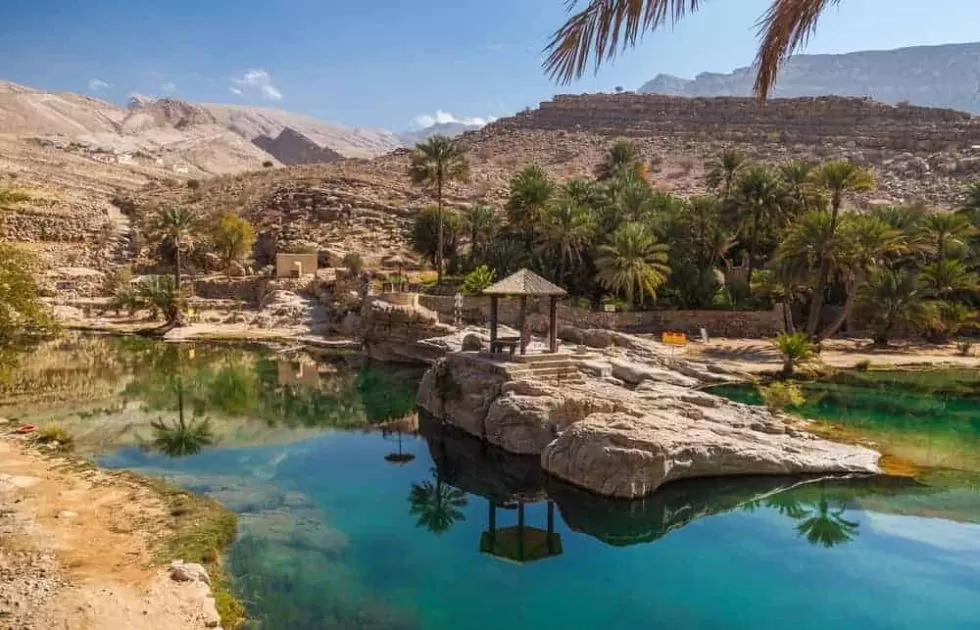
Multi Day Tours
Our city tour Muscat Oman is a mix of culture, history and architecture, perfect for those who want to experience the real deal.
Bilad Sur Castle
Bilad Sur Castle is located in the Al Sharqiyah Governorate of Oman. It was built in the 17th century as part of a defence strategy to protect the surrounding city from attacks by interior tribes.
Bilad Sur Castle is an excellent example of Omani architecture. Four towers overlook the harbour, watch the outskirts, and protect the chip-producing yards.
Andries Oudshoorn, CC BY-SA 2.0, via Wikimedia Commons
The fort is open to the public. However, many tourists don’t visit Bilad Sur Castle simply because it is not well known. But if you want to step back into the history of Oman and ancient times, you should visit this calm and quiet castle.
Mirbat Castle
Mirbat Castle is a popular tourist destination in the Dhofar region of Oman. It is less than an hour’s drive from Salalah. The origin of the Mirbat Castle is not very well known. However, it is famous for a tale from the battle of 1972, when a handful of soldiers of the Mirbat Castle protected the castle during its siege. The Mirbat Castle, like many other forts of Oman, showcases the history of bravery and valour of the Omani people. The Mirbat Castle was restored by the Ministry of Tourism and converted into a museum where visitors can witness the ancient culture, history and life of the people of Oman.
9591353082 at English Wikipedia, CC BY-SA 3.0, via Wikimedia Commons
Taqah Castle
Taqah Castle is situated in the Taqah region of Salalah. It was constructed in the 19th century by Sultan Taimur bin Faisal al Said. The castle of Taqah was not built for defence or ruling purposes; instead, it was built as a private residence for the grandfather of Sultan Qaboos’ mother.
The architecture of Taqah Castle speaks volumes about the craftsmanship and creativity of the Omani people. The castle has two floors and four towers. The ground floor is designated for prison, storage and other activities, while the first floor has rooms and facilities for the royal families living in the castle.
Allan Grey, CC BY-SA 2.0, via Wikimedia Commons
Tourists can visit Taqah Castle by driving from Salalah. It is located approximately 33 East of Salalah. For ease and convenience, taking a taxi or a rented car is advised.
Taqah Castle transitioned from private property to a government estate in the early 20th century. In 1994, after extensive restoration, Taqah Castle opened its doors to the public as a museum showcasing the vibrant culture, heritage and lives of Omani people in the olden times.
Ibri Castle
Ibri Castle is a peaceful castle in the quiet town of Ibri. It was built in the 16th or 17th century.
The fort of Ibrī was built for the residence of the local Wlai/ Imam. The interior of the castle is constructed beautifully with many gates. Ibri Castle has residential rooms, mosques, wells, and horse stables. The mosque of Obri Castle is one of the oldest mosques in Oman and is still being used.
Ibri Castle is open to the public. You can visit the castle and have a peaceful excursion.
J. R. Schmid, CC BY 3.0, via Wikimedia Commons
Conclusion
After reading this detailed account of the forts and castles of Oman, it is safe to say that Oman is the land of forts and castles. These forts and castles are abundant and scattered along the length and breadth of the Sultanate of Oman.
Here are a few takeaways from this article:
- When planning a tour’s itinerary, always include some of the forts along the way.
- Check the opening status of the desired fort or castle, as they are constantly restored and managed to keep them in good shape.
- Always check the current opening hours and entry fee to be prepared beforehand.
- Remember to soak in the beauty and serenity of the forts rather than just clicking pictures.
- These forts are your gateway to the ancient culture and civilisation of Oman.
- Respect these forts and archaeological sites as they are an asset to heritage and culture.
Frequently Asked Questions
Q.No: 01 What is the most famous fort in Oman?
ANS: Oman has many impressive centuries-old forts, some of which are hot tourist destinations. It is hard to pick a single fort. However, Nizwa Fort is the most visited fort. Its landscape, architecture, and grandeur attract tourists worldwide.
Q.No: 02 How many forts are there in Oman?
ANS: The Sultanate of Oman is the land of forts and castles. Oman has many forts dating back to the Stone Age, pre-Islamic times, Portuguese rule, and more recent early 20th-century forts. The number of forts is believed to be 500 to 1000.
Q.No: 03 How many castles are there in Oman?
ANS: There are numerous castles in Oman. These castles were built in oases, wadis and mountains. The number of castles is thought to be 500 to 1000.


